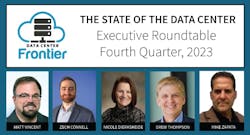Roundtable: Manufacturing Outlook and Possibilities for U.S. Data Center Supply Chains
Although delays and premium pricing persist for certain equipment, since the pandemic, most elements of the supply chain have stabilized for data centers. And yet, a host of present global instabilities, ranging from climate change to wars (with the possibility of another pandemic still at least cracked open), puts the idea of having supply chain options for data centers closer to home in a favorable light not likely to dim any time soon.
For the final installment of Data Center Frontier's Q4 Executive Roundtable we asked our Executive Roundtable for their takes what are the main opportunities might be going into 2024, geographical and otherwise, for an expansion of U.S. manufacturing capabilities for providers of equipment to the North American data center industry looking to bring supply chains for critical infrastructure closer to their customers.
Our Executive Roundtable's expert panelists include:
- Zech Connell, VP, Program Development, BluePrint Supply Chain
- Nicole Dierksheide, Director - Category Large Engines>600KW, Kohler Co.
- Drew Thompson, Associate VP, Commercial, Connectivity and Industrial Group, Black & Veatch
- Mike Zapata, Head of Data Centers, Siemens Smart Infrastructure USA
Now onto the final question for our Executive Roundtable for the Fourth Quarter of 2023.
Data Center Frontier: For providers of equipment to the North American data center industry looking to bring supply chains for critical infrastructure closer to their customers, what are the main opportunities going into 2024, geographical and otherwise, for an expansion of U.S. manufacturing capabilities?
Zech Connell, BluePrint Supply Chain: Project owners and equipment manufacturers must streamline and optimize their industrial supply chains.
On the one hand, we need to improve the availability and transport time of raw materials and component parts.
Manufacturers and integrators require greater coordination and cooperative demand planning to ensure a constant and reliable flow of mission-critical materials and components.
Supply chain companies, on the other hand, must improve their efficiency by implementing technology to improve visibility, choosing fewer, more stable channel partners, and establishing a system of common operating and metrics standards.
Essentially, better planning and management can improve the lives of all demand ribbon constituents.
Nicole Dierksheide, Kohler: There are many different factors to consider when exploring areas of opportunity for expansion in North America for data center equipment providers.
A few factors that are potential markers for growth and expansion include the identification of which markets are offering incentives or chairing concentrated initiatives to bring better connectivity to their communities.
Additionally, looking beyond major metropolitan hubs is another opportunity for growth, as working from home and digital integration into everyday lives shows no sign of slowing down.
Drew Thompson, Black & Veatch:
• International equipment providers are developing dedicated manufacturing and distribution facilities near high demand data center communities, and in some cases for specific data center operators.
• Global design and construction firms are working with systems integrators and distribution companies to develop improved template designs that better support early procurement programs.
• Realizing the need for onshore manufacturing was a major outcome of the pandemic. To alleviate the U.S. reliance on overseas equipment supply, the CHIPS Act, Inflation Reduction Act, and many state legislations were passed to incentivize and facilitate the construction of certain manufacturing facilities in the US. Additionally, many manufacturers are moving their operations to Mexico to be closer to the end customer. The anticipated outcome is a higher supply of equipment and equipment subcomponents readily available in the U.S.
• New manufacturing facilities in North America have the opportunity to leapfrog the development of overseas facilities by anticipating the needs of our post-pandemic society. One trend in modern construction has been modular fabrication. The benefits of modular construction are being realized as a solution to historical construction concerns, including safety, sustainability, and field staffing shortages. Combining new fabrication methods with modular construction is an opportunity for equipment suppliers in the modern construction industry.
Mike Zapata, Siemens Smart Infrastructure USA: Siemens is doubling down on our investment into North American supply chain to support our customers with respect to electrification, energy transition and digitalization.
North America has proven there is a demand and scale of the customers to help justify such investments.
Siemens has already announced several major investments of more than $500 million in U.S. manufacturing for critical infrastructure in 2023 to support high-growth markets.
This also includes a focus on supply chain resiliency to help avoid the challenges learned from the pandemic.
In every way, we’re using our investments and our portfolio to create productive and sustainable factories to meet current and future market demands and help create jobs in the process.
Next: Data Center Frontier Q4 Executive Roundtable Recap

Matt Vincent
A B2B technology journalist and editor with more than two decades of experience, Matt Vincent is Editor in Chief of Data Center Frontier.










